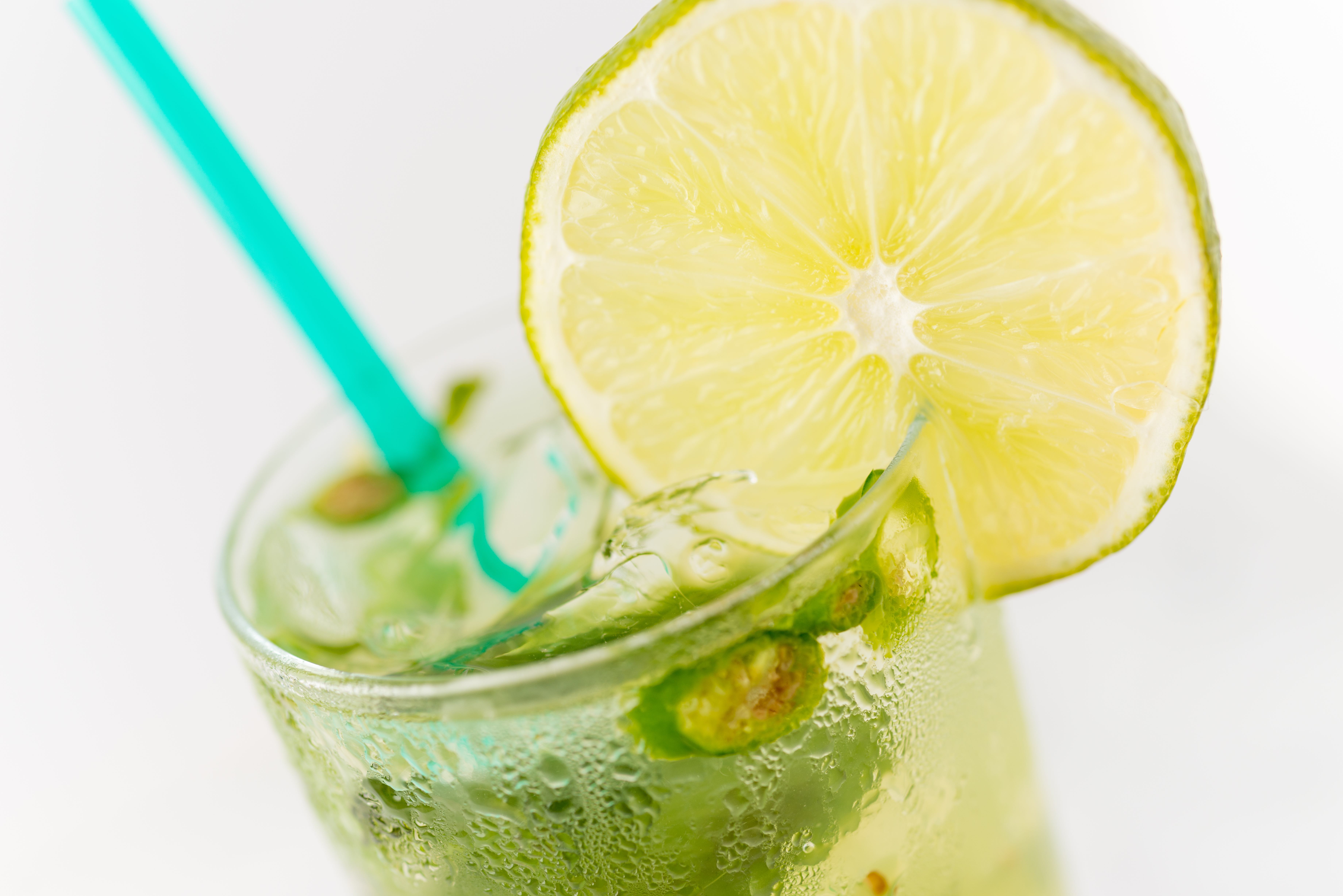Jalapeño Lemonade Slushies

Jalapeño Lemonade Slushies
Some of the hottest countries in the world have the spiciest cuisine and that’s probably no accident. Why? Because spicy foods make us sweat, and sweating is our bodies’ way of cooling us down! Pretty smart, huh? Think about that when you’re slurping on your Jalapeño Lemonade Slushie!
Happy & Healthy Cooking,
Fun-Da-Mentals Kitchen Skills
- blend :
to stir together two or more ingredients until just combined; blending is a gentler process than mixing.
- measure :
to calculate the specific amount of an ingredient required using a measuring tool (like measuring cups or spoons).
Equipment Checklist
Ingredients
Jalapeño Lemonade Slushies
- 3 lemons, juiced
- 1/2 C white sugar
- 1/2 jalapeño, chopped roughly (if concerned about safety, sub mild poblano pepper)
- 4 C cold water
- 3 to 4 C ice (optional)
Instructions
Jalapeño Lemonade Slushies
chop + measure + blend
Carefully, cut 1/2 jalapeño in rough pieces. (Remove the seeds and white from the inside of the jalapeño to remove some spiciness.) Combine the chopped jalapeño, 1/2 cup sugar, 1/2 cup water, and the juice of 3 lemons** in your blender (or pitcher + immersion blender) and blend until the jalapeño is completely blended. Then, pour in 3 1/2 cups of water and blend once more.

Hi! I'm a Jalapeño!
"My name is Spanish! If you need help pronouncing it, try this: HAHL-ah-PAY-nyoh. I'm a type of chili pepper. I have a medium heat, not too mild nor too hot—perfect for many dishes and tastes!"
History & Etymology
- Jalapeños (HAHL-ah-PAY-nyohs) are chili peppers with mild hot heat. They can fall between 2,500 to 8,000 Scoville heat units (SHU).
- As a comparison, a pimiento is a mild pepper and has 0 to 500 heat units on the Scoville scale, poblanos are somewhat mild with 1,000 to 2,000 SHU, cayenne and tabasco have 30,000 to 50,000 SHU, and a habanero has 100,000 to 350,000 SHU. The scale goes up to more than 2,500,000 SHU! Now, that's hot!
- The Aztecs in Mesoamerica ate jalapeños during the 14th to 16th centuries. Bernardino de Sahagún, a Franciscan friar, missionary priest, and ethnographer, wrote about Aztec markets selling fresh jalapeños, chipotles (smoked jalapeños), and mole sauce made from chipotles while studying their culture.
- Mexico produces the most jalapeños worldwide. California produces the most in the United States, followed by New Mexico and Texas.
- The jalapeño has been the official state pepper of Texas since 1995.
- According to Guinness World Records, the record for eating the most jalapeños in one minute was set by Alfredo Hernandes in Chicago on September 17, 2006. He ate 16 jalapeños at the La Costeña Feel the Heat Challenge.
- The name "jalapeño" is from the Spanish for "from Xalapa," the capital city of the Mexican state of Veracruz.
Anatomy
- The jalapeño plant is from the Capsicum annuum species in the Solanaceae or Nightshade family of flowering plants. The plants grow to around 2 1/2 feet tall. They prefer a warm climate.
- The jalapeño plant's fruit is a medium-sized, pod-type chili pepper. The plant produces an average of 30 pods. Peppers are picked throughout the growing period of 70 to 80 days.
- Jalapeños start green and eventually turn red. They may have different levels of capsaicin, the chemical compound that creates the heat in chili peppers, depending on the climate and the soil in which they are grown.
- Sweet hybridized varieties are available that have the flavor of jalapeños without the heat.
How to Pick, Buy & Use
- Pick jalapeños when they are still green before turning red, which means they are overripe. They should be between 2 to 4 inches long. Once they turn red, they will be spicier and sweeter.
- When choosing fresh jalapeños, look for firm, dark green peppers without wrinkles. If you prefer mild jalapeños, choosing younger, smooth ones without white or brown lines (striations or corking) may give you the best result. More mature peppers have striations, and more lines can mean more heat.
- Capsaicin is generally more prevalent in and around the seeds, so remove the seeds and ribs if you want to eliminate much of the heat.
- It is a good idea to wear gloves or coat your hands with oil when handling jalapeños. Avoid touching your eyes, and wash your hands thoroughly after working with them.
- Fresh jalapeños will last three to five weeks when stored in the refrigerator. Put them in a paper or perforated plastic bag in the crisper drawer.
- You can also purchase brined or pickled, whole or sliced jalapeños in cans or jars.
- Raw jalapeños can be a fresh ingredient or garnish for salsa, pico de gallo, guacamole, nachos, tacos, enchiladas, salads, and drinks.
- Fillings for baked or fried jalapeño poppers or stuffed jalapeños may include cheese (cheddar, cream, Monterey jack), garlic, onions, bacon, salt, and other seasonings.
Nutrition
- Raw jalapeños are 92 percent water with negligible fat or protein. They are a rich source of vitamin C, a moderate source of vitamins B6, E, and K, and a good source of potassium.
History of Lemonade!

- Lemonade was probably the first of the fruitades. Egyptians made a drink with lemons and sugar cane called "qatarmizat" in the 11th century. In 1676 a Parisian company was the first to sell lemonade.
- Frozen lemonade was first made and sold in the local market in Naples, Italy, in 1840 by Signore DeLucia. His son, Franco, brought it to the United States around 1900. Franco's son, Angelo, produced a machine to create consistent frozen lemonade, and in 1948, Del's Frozen Lemonade was first sold at a stand in Rhode Island.
- Old-fashioned lemonade, or cloudy lemonade, is made from the juice of freshly squeezed lemons, non-carbonated water, and sugar and is a very popular summer drink in the US and Canada.
- Pink lemonade includes other fruit juice, like grape juice, or food coloring to make it pink. Ireland uses brown sugar to sweeten their lemonade and calls it brown lemonade.
- Many countries have other varieties, including France, which serves "citron pressé," providing lemon, water, and sweetener to customers who prefer to measure and mix their own lemonade.
-
To get even more flavor from the lemon (or any fruit), you can make a lemon crush by pressing (muddling) pieces of the squeezed, unpeeled lemon (make sure it's been washed!) in the bottom of the glass or pitcher.
-
Limeade is another popular citrus fruit-flavored drink made with lime juice, water, and sugar. Brazilian or Swiss Lemonade is actually a limeade (limonada) made with pieces of unpeeled lime, sugar, water, sweetened condensed milk, and ice cubes.




